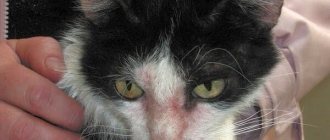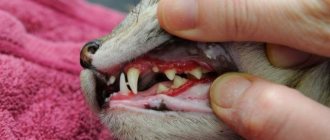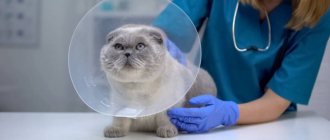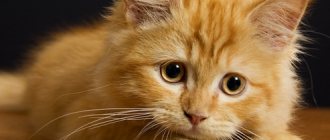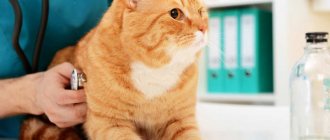Pulmonary edema in cats is a serious pathology that is associated with the accumulation of fluid in the alveoli of the lungs, which complicates the process of gas exchange and causes oxygen starvation. Lack of oxygen for a long time leads to the death of brain cells, and suffocation can cause the death of the animal.
When the first signs of pulmonary edema appear in a cat, you must urgently seek help from a veterinarian; the lack of timely treatment will lead to the painful death of your pet.
Causes
Cardiogenic causes are associated with various diseases of the cardiovascular system.
The most common cardiogenic
The causes of pulmonary edema in cats include the following diseases:
- cardiomyopathy;
- heart disease;
- pulmonary embolism.
It is precisely because of the risk of developing cardiogenic pulmonary edema that all cats are recommended to undergo cardiac ECHO before any anesthesia. HCM occurs in all cats, but there are breeds at risk in which this pathology occurs much more often - for example, in British, Scottish cats and their mixed breeds, Maine Coons, and Norwegian Forest cats.
Non-cardiogenic
Causes of pulmonary edema in cats:
- shock;
- infectious diseases;
- multiple organ failure, sepsis;
- respiratory failure (foreign body, brachycephalic syndrome, neoplasms of the respiratory tract and lungs;
- aspiration (inhalation) of vomit, food, water;
- cat poisoning (gases, poisons);
- transfusion hypervolemia (with excessive intravenous infusion).
A state of shock in a cat can occur as a result of a burn, chest injury, acute allergic reaction, or sepsis.
Main causes of thoracic hydrops
Hydrothorax in cats develops due to the accumulation of edematous fluid (transudate) in the pleural zone. This is caused by the high permeability of the pleura, as well as lymphatic and blood vessels. Transudate “leaks” between the pleural layers, provoking the development of thoracic hydrops and the appearance of the main symptoms of the disease.
Causes of hydrothorax in cats:
- Infectious diseases.
Pathogenic microorganisms disrupt the permeability of the pleura and capillaries, which leads to the development of thoracic hydrops. Among the infectious diseases that can lead to hydrothorax: actinomycosis, nocardiosis, panleukopenia, etc.
- Mechanical damage to the chest.
Severe trauma (such as a fall from a great height onto the chest area) can result in serous fluid effusion in cats. As a result of mechanical compression, not only blood vessels are damaged, but also lymphatic vessels.
- Violations of internal organs.
Diseases of the cardiovascular system, liver, kidneys or respiratory organs can cause thoracic hydrops in cats. For example, congestive processes in the heart muscle lead to intense effusion of edematous fluid into the chest.
- Helminthic diseases.
Compression of blood vessels in the liver during echinococcosis (a chronic parasitic disease) often causes chest dropsy. The only way to avoid this is to promptly carry out antiparasitic treatment in a veterinary clinic.
- Oncological pathologies.
Tumors located in the respiratory or digestive system lead to hydrothorax. Enlarged lymph nodes, metastases, compression of the lymphatic duct - all this leads to the effusion of edematous fluid into the chest.
Hydrothorax can be caused not only by these, but also by other reasons (blood clotting disorders, damage to blood vessels, low levels of protein in the blood, etc.). Only a specialist can determine the exact cause that provoked the development of thoracic hydrops. If you suspect that your cat has hydrothorax, do not hesitate - contact a veterinary clinic in Moscow.
Symptoms
If two or more signs occur, the owner must immediately contact the clinic, especially if the pet has cardiac problems or has recently been under anesthesia (up to 2 weeks). Symptoms may be associated with other lung pathologies, but in any case, this means that the cat requires medical attention.
Signs of a condition such as pulmonary edema are:
- Shortness of breath, abdominal type of breathing (the cat breathes with its stomach).
- Rattles and gurgles when the cat breathes.
- Breathing with an open mouth “like dogs.” This type of breathing is not typical for cats, only within one to two minutes after physical activity.
- Cyanosis (the cat's mucous membranes are blue or purple).
- Severe lethargy and weakness due to hypoxia (lack of oxygen).
- Cough.
Symptoms of hydrothorax: how to recognize the disease in your pet?
The first thing you need to pay attention to is your pet’s behavior. With hydrothorax, shortness of breath gradually develops, the body temperature remains normal, but due to internal changes, the mucous membranes become bluish (cyanosis). When palpating the chest area, there is no pain, but there is swelling.
One of the features of hydrothorax is its stages. Periods of exacerbation may be followed by temporary relief. However, don’t mistake this for recovery! Remember that hydrothorax in cats requires professional veterinary treatment.
Signs of hydrothorax (dropsy) in cats:
- general weakness,
- fast fatiguability,
- increasing shortness of breath,
- appetite disorders,
- cyanosis of the mucous membranes (pressure restores the natural color),
- swelling in the perineum, chest, eye area and paws.
A cat suffering from dropsy loses the desire to play. She spends more time in solitude, has virtually no contact with people, and does not go into arms. With hydrothorax, animals lie down with their paws widely spread forward and their heads stretched upward. Breathing becomes heavier (long inhalation and short exhalation).
Diagnosis of pulmonary edema
Diagnosis of pulmonary edema in cats is based on medical history, clinical symptoms, auscultation (listening to lung sounds) and radiography. However, if the cat is in critical condition and there is a threat to life, primary treatment should be carried out without additional diagnostics until the condition has stabilized.
After relief of the acute condition (the treatment algorithm is similar, regardless of the cause), additional diagnostics should be carried out to determine the cause.
First aid before going to the veterinary clinic
If there are signs of pulmonary edema, immediate assistance to the animal is very important, since it determines whether resuscitation will be successful. Before delivering the cat to the clinic, it is necessary to make the breathing process as easy as possible for her using improvised methods:
- give an injection of a diuretic (Furosemide);
- open the windows or take the cat out into the fresh air;
- provide the animal with complete rest and limit physical activity;
- do not disturb or take any forceful action towards him;
- deliver to the clinic as quickly as possible;
- During transportation, it is advisable to place the animal on its side.
If first aid is provided correctly, then subject to a professional approach to the choice of treatment method, there is hope that the animal will recover.
Treatment of pulmonary edema in cats
Pulmonary edema in cats is a dangerous, life-threatening condition that requires an emergency visit to the doctor. Treatment of pulmonary edema should be carried out in a veterinary clinic
with constant monitoring of the cat’s condition in a hospital setting. This is a condition that requires not only intensive care, but also often resuscitation.
Severe cases of pulmonary edema require medical equipment (ventilator, oxygen unit). Therefore, the sooner you deliver the cat to the clinic, the greater the chance of stabilizing the animal’s condition. Delay can be fatal for your cat.
It is necessary to provide the cat with rest and oxygen therapy (oxygen supply using a mask or placement in an oxygen chamber). All drugs are administered predominantly intravenously or intratracheally.
A drip is prescribed to restore electrolyte balance. Diuretics (diuretics) and, in some cases, steroid hormones are used. It is also possible that it will be necessary to connect the animal to a ventilator.
First of all, acute symptoms are relieved, the condition is stabilized, followed by pathogenetic treatment, that is, elimination of the cause, if possible.
Video with an excerpt from a lecture on the diagnosis and treatment of pulmonary edema in cats.
Treatment
The treatment regimen should be aimed at identifying and eliminating the cause that caused pulmonary edema and providing first aid.
First aid
Regardless of the root cause, first aid for this pathology includes:
- Therapy with diuretics - diuretics. Allows you to remove excess fluid from the cat’s body.
- Oxygen therapy. The animal is placed in a pressure chamber or an oxygen mask is put on it.
- In severe cases, intubation or artificial ventilation is prescribed.
- Decongestant therapy. The cat is given injections of Prednisolone, Dexamethasone or Hydrocortisone. Relieves acute hypoxia.
- Vasodilators open blood vessels and prevent fluid formation.
- Sedatives and drugs and analgesics.
- Novocaine blockade.
If all of the above methods do not help, surgical methods are used to remove fluid from the lungs.
Further therapy
When the crisis has passed, the cat is placed in a cool room with good ventilation, but without drafts.
Further treatment includes symptomatic therapy (coughing drugs, antibiotics) and elimination of the root cause of the pathology. Depending on the cause that led to the swelling, the doctor prescribes a set of medical measures.
If the condition is caused by injury, poisoning, suffocation, or an allergic reaction, then after the symptoms are removed, the cat’s life is not in danger. The animal is discharged from the hospital home for maintenance therapy.
If a cat has cardiogenic edema, an accurate diagnosis is made and a treatment regimen is prescribed. Many heart diseases are incurable and require lifelong monitoring and special medications.
Viral and bacterial causes are eliminated using antibiotics and antiviral agents.
The list of diseases that can provoke this dangerous pathology is impressive. Therefore, the treatment regimen in each specific case will be individual. The cat's owners will only have to strictly adhere to the veterinarian's recommendations and provide the pet with good care and nutrition.
Preventing pulmonary edema in cats
If we are talking about animals with previously diagnosed cardiac pathology, regular examination of the animal by veterinary specialists, accurate determination of the functional degree of heart failure and timely treatment will help avoid the development of pathology.
Prevention of cardiogenic edema in young, clinically healthy animals involves conducting screening studies before surgery, this is especially important if the cat belongs to risk breeds.
(c) Veterinary center for the treatment and rehabilitation of animals “Zoostatus”. Varshavskoe highway, 125 building 1. tel. 8 (499) 372-27-37
Types of disease
Based on the rate of progression of symptoms, several types of disease are distinguished:
- Lightning fast - has rapid development, leading to rapid death.
- Acute - characterized by a high rate of development. Symptoms increase over several hours. In this case, prompt treatment is the only way to save the animal.
- Subacute - has a wave-like development. Periods of increasing symptoms are followed by periods of subsiding.
- Protracted - has erased symptoms. Characteristic of chronic pathologies.
Disease prevention
There are no special preventive measures to protect against the disease. Prevention consists of careful monitoring of animals that are at risk for cardiovascular and colds. These are predisposed breeds (Maine Coons, Sphynxes, Persians, Scottish, British), weakened, with low immunity, overweight, animals that move little.
If the disease is cured in time, then we can say with a high degree of confidence that complications will not develop.
The main preventive measures are:
- protect the cat from physical overload;
- protect from unfavorable environmental conditions (avoid overheating and hypothermia, being in drafts);
- monitor the safety of cats and kittens at home (protect access to wires and electrical appliances, ensure that the animal cannot inhale fumes of aggressive chemicals, protect from falls and injuries);
- strengthen the immune system, do not skip scheduled vaccinations;
- undergo regular preventive examinations with a veterinarian.
The disease often has a poor prognosis. But the attention and love of the owner can work a miracle. Competent and timely veterinary care (especially in non-cardiogenic disease) makes the chances of recovery quite high.


